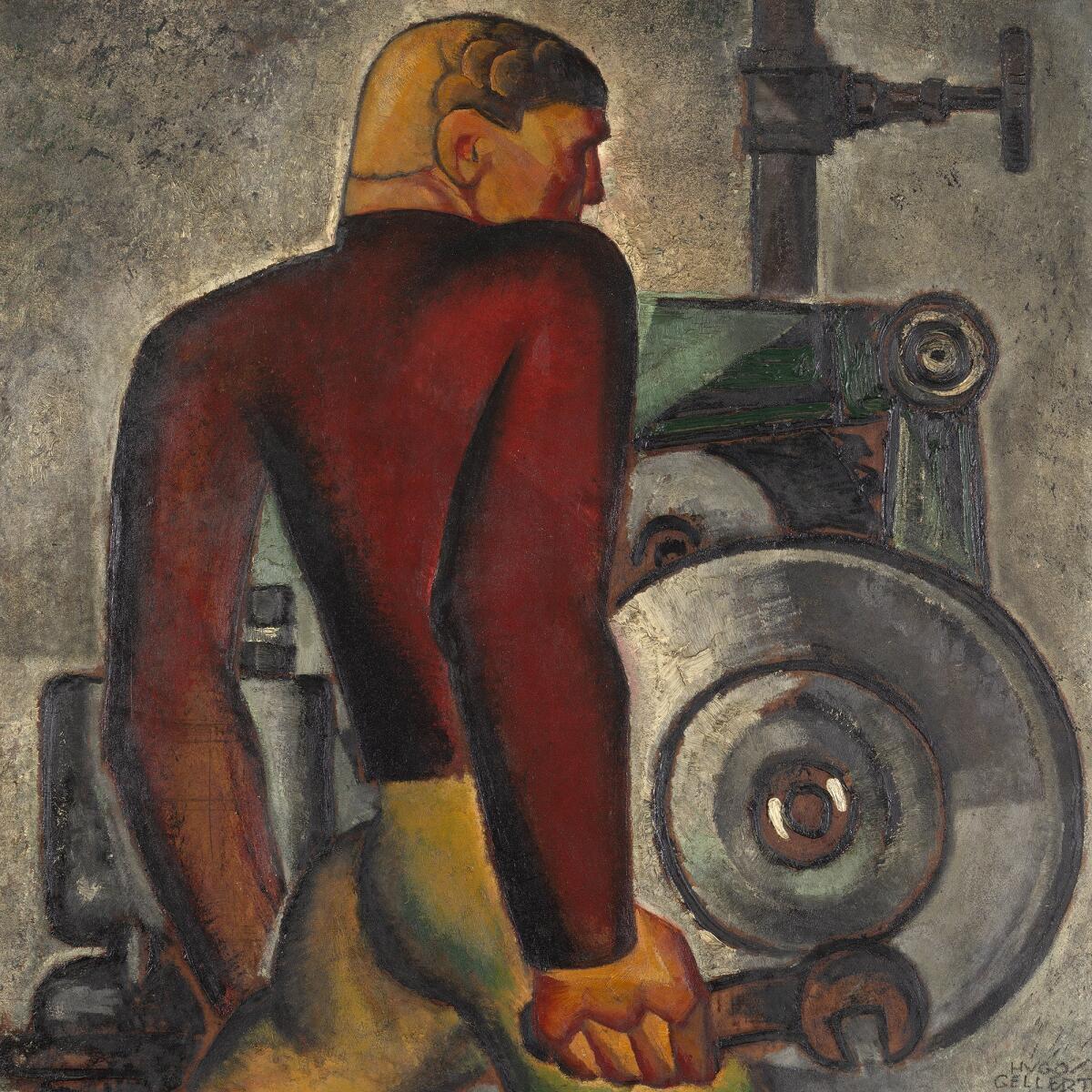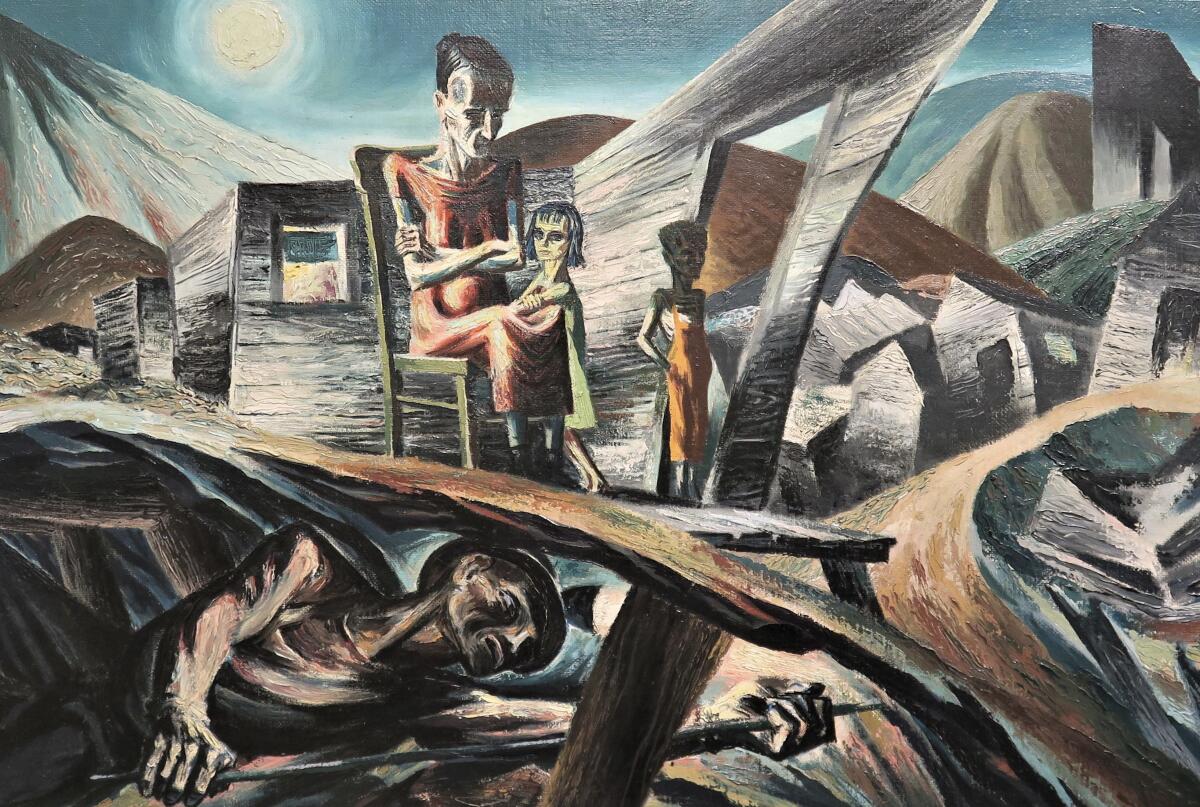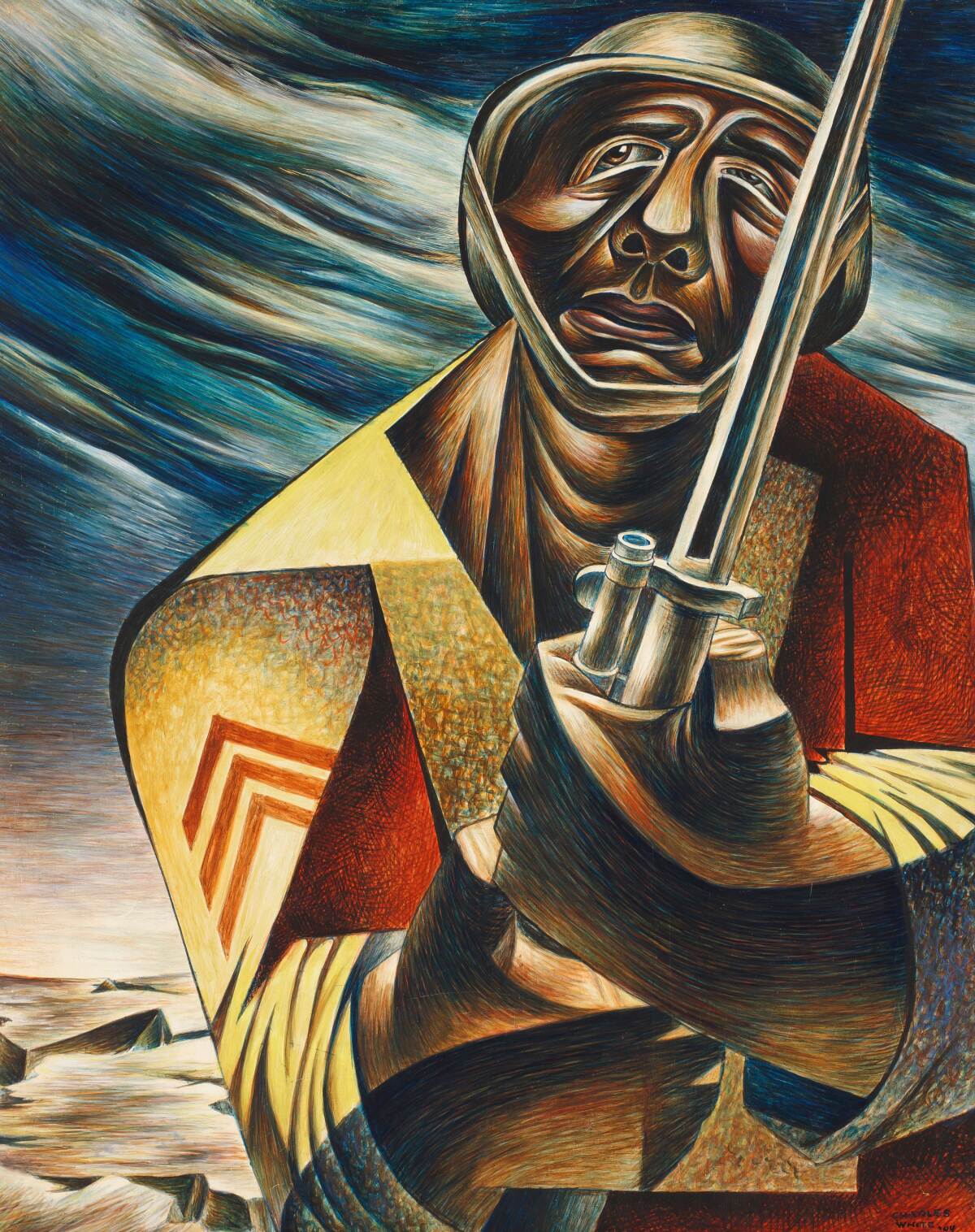Here is
a column by Michael Hiltzik, which summarizes some of the characteristic of the underbelly of Capitalism that get shut down by the conservative Republican Party, who are adamant about keeping this information from the general public. It all ties in with the dumbing down of America where it is believed that showing what is wrong with America is not fit to be known. This is better viewed if you have access to the LA Times, than this hasty sloppy cut-and paste job.
Column: Remembering when the government wasn't afraid to let artists tell the truth about capitalism

Mitchell Siporin (1939), "Homeless" (Bram and Sandra Dijkstra Collection)
BY MICHAEL HILTZIKBUSINESS COLUMNIST
SEPT. 7, 2023 3 AM PT
Three men huddle around a lit fire in an oil drum. An entire community of the dispossessed goes about its day, here hanging laundry or carrying water in buckets, there mending a tattered shirt. A homeless family stands disconsolately before their wrecked home.
"You could see this scene today," Bram Dijkstra says of the family portrait. It's not from today, however. These are paintings from the Depression 1930s, when federally funded arts programs freed artists to depict the underside of American capitalism as they saw it with their own eyes.
These paintings and many other examples of what Dijkstra calls American Expression are currently on display at the Oceanside Museum of Art.
Abstraction was supposed to be the great thing of the moment, but one of the nice things about abstraction is that there was no content—you could look at the picture and see nothing except construction.
— Bram Dijkstra
The exhibition, titled "Art for the People: WPA-Era Paintings from the Dijkstra Collection," was launched earlier this year at the Crocker Art Museum in Sacramento. It will run in Oceanside through Nov. 5, then transfer to the Huntington Library in San Marino from Dec. 2 through March 18.
Although Dijkstra is correct to say that the images from the '30s could serve for the America of today, it's doubtful that their creators could be supported with government funds.
The anti-"woke" movement so beloved of conservative Republicans would never accept depictions of an American underclass or questioning of the nobility of American capitalism today. Nor would Democrats beholden to wealthy and corporate donors be inclined to fight for such funding.
Clear-eyed, truthful portrayals of American history and contemporary affairs have long been disfavored as beneficiaries of public funding — though the movement to strip them out of classrooms, textbooks and school libraries has seldom been as ferocious as it is currently.

Hugo Gellert (1928), "Worker and Machine"
(Bram and Sandra Dijkstra Collection)
Dijkstra and his wife, Sandra, assembled their collection "literally by haphazardly finding things," Dijkstra, a cultural historian and emeritus professor of comparative literature at UC San Diego, told me.
Gellert
Hugo Gellert (1928), "Worker and Machine" (Bram and Sandra Dijkstra Collection)
They stumbled upon one piece — a 1928 social realist portrait by the Hungarian-born artist Hugo Gellert of a burly worker wielding an iron wrench — hanging over the fireplace of a secondhand bookshop in an old Long Beach home. (Disclosure: Sandra has been my literary agent for nearly 20 years.)
Many works are by artists whose heydays were in the 1930s and 1940s, but who fell into undeserved obscurity as artistic fashion in the U.S. moved away from the humanism of their approach toward depoliticized, deliberately unrealistic abstract modernism.
As the show's subtitle indicates, the key funding source for many of these artists was the Works Progress Administration, a New Deal relief agency that would put more than 8 million jobless Americans to work filling the American landscape with highways, bridges, parks and public buildings such as the Griffith Park observatory in Los Angeles, many of them still in use today.
The WPA was headed by Harry Hopkins, a New Deal aide who worked with the settlement house anti-poverty movement before moving into politics. His background made him profoundly sensitive to the plight of the dispossessed and impervious to criticism of his efforts to assist them.
"They are damn good projects — excellent projects," he shot back. "God damn it! Here are a lot of people broke and we are putting them to work.... As a matter of fact, we have not done enough."
The most culturally significant program of the WPA was the amalgamation of arts programs known as Federal One, encompassing the program for painters and sculptors; the Federal Music Project, which sent orchestras around the heartland to expose millions of Americans to classical music; the Federal Writers' Project, which turned out a prodigious series of guidebooks to every one of the 48 states; and the Federal Theatre Project, which not only supported Black playwrights and productions, but launched the career of a precocious theatrical actor and director named Orson Welles.

Harry Sternberg (1938), "Coal Miner and Family" (detail)
(Bram and Sandra Dijkstra Collection))
sternberg miner
Harry Sternberg (1938), "Coal Miner and Family" (detail) (Bram and Sandra Dijkstra Collection))
Taken all together, the works in the Dijkstra collection tell an impressionistic narrative about Depression-era suffering that art historian Henry Adams, a co-author of the exhibition catalog, writes was neglected, even disdained, by the American artists of the period "generally accepted as artistic giants," such as Grant Wood and Georgia O'Keeffe.
The vacuum was filled, with the help of government programs such as the WPA, by artists outside the cultural mainstream — immigrants and children of immigrants, city dwellers and Jewish artists who journeyed into the heartland and "saw things from a newcomer's standpoint" and "a fresh perspective," Adams writes.
WASHINGTON, DC - MAY 14: Rep. Elise Stefanik (R-NY) speaks during a news conference after the GOP Conference Chair election on Capitol Hill on Friday, May 14, 2021 in Washington, DC. House Republicans formally selected Rep. Elise Stefanik (R-NY) Friday to replace Rep. Liz Cheney (R-WY). (Kent Nishimura / Los Angeles Times)
Many Americans did not need to be told about racial discrimination or deep poverty or the hardships of manual or factory labor — they lived those experiences personally. What the WPA artists communicated was that these experiences were shared by Americans across the land.
In "Coal Miner and Family" (1938) by Harry Sternberg, a miner chips away at a coal seam underground while his emaciated wife and children wait on the surface above him amid mining debris and ruined houses. William Ashby McCloy's 1936 "Lost Horizon" could be a gloss on Grant Wood's 1930 "American Gothic," this time with the farming couple crouched in defeat next to a plow and a drained water barrel in a bare dust-bowl landscape.
The single most striking work has to be Charles White's 1944 "Soldier," the subject standing in solitude under a livid sky, clutching his rifle, existential dread and despair on his face — a deliberate counterpoint by White, who had just been drafted at the age of 26, to the propaganda of America's enthusiasm for saving the world from fascism by entering the war.
The single most striking work has to be Charles White's 1944 "Soldier," the subject standing in solitude under a livid sky, clutching his rifle, existential dread and despair on his face — a deliberate counterpoint by White, who had just been drafted at the age of 26, to the propaganda of America's enthusiasm for saving the world from fascism by entering the war.
 Harry Sternberg (1938), "Coal Miner and Family" (detail)
Harry Sternberg (1938), "Coal Miner and Family" (detail)(Bram and Sandra Dijkstra Collection))
Charles White (1944), "Soldier" (The Huntington Library, Art Museum, and Botanical Gardens)
Not all the exhibition's works portray a working-class grimness. Several from the California School are uplifting celebrations of the state's natural and urban wonders — such as a view from a window with pink peonies in the foreground, looking up San Francisco's Telegraph Hill at Coit Tower by Miki Hayakawa (a central figure in the city's art community who was forced to relocate to Santa Fe in 1942 during the mass eviction of Japanese residents from California).
"Construction Workers: Solidarity in Action" (1941) by Italian-born Emanuel Romano depicts four workers raising a construction girder in choreographed synchronization, an eerie prefigurement of the photo and monument of the flag-raising on Iwo Jima.
Programs like the WPA became a lightning rod for attacks on the New Deal generally. Republicans and conservatives questioned why the government should pay workers to create culture, as opposed to assembling bricks and mortar — although Federal One accounted for a minuscule half of 1% of the WPA's total budget from its launch in 1935 through its shutdown in 1939.
Their real objection was political. That became clear in 1947, when the State Department assembled an exhibition titled "Advancing American Art" that was to traverse the globe on a five-year journey.
The Republican National Committee and conservative publications such as Henry Luce's Time and Fortune stoked public outrage over the handful of works in the show with a socially conscious theme, depicting the poverty and racial discrimination that America supposedly had transcended.
They raised alarms over the leftist, socialist, even Communist backgrounds of many of the artists. Some of these attacks emitted the acrid odor of antisemitism, as many of their targets were Jewish. The State Department canceled the world tour.
"This was the first national blitz against a specific form of art," Dijkstra says.
The WPA itself had fallen to philistines after Hopkins moved up to the cabinet post of Commerce Secretary in 1938, and was shut down in 1943. The agency put the entire contents of its warehouse in New York City up for auction, selling a ton of bundled canvases to a junk dealer for four cents a pound. Luckily the dealer examined his haul and passed the canvases on to a second-hand book dealer, who sold them on to artists, experts and dealers at fire-sale prices.
Artists and their patrons got the message, Dijkstra says. In the postwar years their interest turned to abstract art. "Abstraction was supposed to be the great thing of the moment, but one of the nice things about abstraction is that there was no content — you could look at the picture and see nothing except construction," Dijkstra told me. That suited corporate arts funders, who didn't have to worry about stepping into a political mire.
Government support of art and artists will never be uncontroversial. Poet W.H. Auden considered the WPA arts programs to be at once noble and absurd: "To consider, in a time of general distress, starving artists as artists and not simply as paupers is unique to the Roosevelt Administration," he wrote, warning that "a state can only function bureaucratically and impersonally," without the discretion needed to judge art.
The National Endowment for the Arts, created as part of Lyndon Johnson's Great Society in 1965, is a perennial target of partisan bluenoses accusing it of all varieties of offenses against public morals and sensitivities, though efforts to abolish it have consistently failed.
The WPA art of the 1930s aimed to shine a spotlight on all the ways that American reality fell short of the American ideal. The culture warriors of today want to erase that reality entirely — in contemporary as well as historical America.
Today's partisan assault on cultural expression aims to depict the very existence of artistic insight as a danger to society itself. It's a uniquely philistine movement, but its political consequences are its most troubling aspect.
****
Juan
Juan
Q. What is the difference between a law-abiding gun owner and a criminal?
A. The .2 of a second that it takes to pull a trigger.

No comments:
Post a Comment